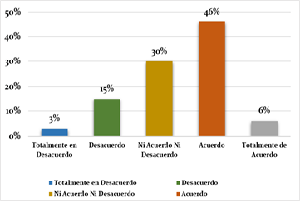Motivation of judicial decisions from a gender perspective in cases of violence against women
DOI:
https://doi.org/10.51252/rcri.v2i2.389Keywords:
arbitrary, differences, standards, magistrates, processes, sentencesAbstract
The objective of the study was to determine if the sentences issued in processes of violence against women in the Judicial District of San Martín are motivated by gender perspective criteria. The research was basic, non-experimental, descriptive level, with a quantitative approach; Surveys assessed on a Likert scale were used, the same ones that were validated by expert judgment with an average of excellent: 88% in a range of 81-100%; whose reliability statistics of the instrument through the Cronbach's Alpha test, was 70.1%, the instrument was applied to the magistrates and jurisdictional personnel (judicial specialists), of the judicial district of San Martín-Tarapoto- N° of elements 20 , the data obtained were processed through the SPSS software. Thus, among those surveyed, a high rate of lack of motivation was noted for judicial decisions based on a gender approach in processes of gender violence, the same ones that would not be eliminating arbitrary differences between women and men; that, although the judge is aware of international legal standards, he does not apply them. Research generally confirms the proposed ideas.
Downloads
References
Caballero Nuñez, J. (2018). La motivación de las decisiones judiciales : justificación suficiente : instrumento de garantía constitucional. Intermilenio.
Hasanbegovic, C. (2016). Violencia basada en el género y el rol del Poder Judicial. Revista de La Facultad de Derecho, 40, 119–158. https://doi.org/10.22187/RDF201616
Jaramillo-Bolivar, C. D., & Canaval-Erazo, G. E. (2020). Violencia de género: Un análisis evolutivo del concepto. Universidad y Salud, 22(2), 178–185. https://doi.org/10.22267/RUS.202202.189
Niño Patiño, N. (2019). Perspectiva y enfoque de género: herramienta para la toma de decisión judicial. Temas Socio-Jurídicos, 38(77), 11–28. https://doi.org/10.29375/01208578.3741
Convención sobre la eliminación de todas las formas de discriminación contra la mujer. (1981) (Organización de las Nacional Unidas). https://www.ohchr.org/es/instruments-mechanisms/instruments/convention-elimination-all-forms-discrimination-against-women
Convención Interamericana para Prevenir, Sancionar y Erradicar la Violencia contra la Mujer “Convención Belém do Pará”.(1994) (Organización de los Estados Americanos). http://www.oas.org/juridico/spanish/tratados/a-61.html
Comité para la Eliminación de la Discriminación contra la Mujer. (2010) (Organzación de las Naciones Unidas). https://www.ohchr.org/es/treaty-bodies/cedaw
Constitución Política del Perú. (1993) (testimony of Presidencia de la República del Perú). https://www.gob.pe/institucion/presidencia/informes-publicaciones/196158-constitucion-politica-del-peru
Ramírez Velásquez, J. C., Alarcón Vélez, R. A., & Ortega Peñafiel, S. A. (2020). Violencia de género en Latinoamérica: Estrategias para su prevención y erradicación. Revista de Ciencias Sociales, 26(4), 260–275. https://doi.org/10.31876/RCS.V26I4.34662
Tello Gilardi, J. (2020). Análisis del feminicidio desde la perspectiva de género y el rol del poder judicial en el Perú. FEMERIS: Revista Multidisciplinar de Estudios de Género, 5(1), 82–106. https://doi.org/10.20318/FEMERIS.2020.5156
Sentencia del Tribunal Constitucional - Exp. N.° 01479-2018-PA/TC. (2019) (Tribunal Constitucional). https://tc.gob.pe/jurisprudencia/2019/01479-2018-AA.pdf
Villanueva Flores, R. (2017). Enseñanza del Derecho y perspectiva de género: ¿Dónde estamos y hacia dónde vamos? El caso de la Pontificia Universidad Católica del Perú (PUCP). Academia. Revista Sobre Enseñanza Del Derecho, 17(33), 43–71. https://revistas-colaboracion.juridicas.unam.mx/index.php/revista-ensenianza-derecho/article/view/38589

Published
How to Cite
Issue
Section
License
Copyright (c) 2022 Felix Freyre Pinedo

This work is licensed under a Creative Commons Attribution 4.0 International License.
The authors retain their rights:
a. The authors retain their trademark and patent rights, as well as any process or procedure described in the article.
b. The authors retain the right to share, copy, distribute, execute and publicly communicate the article published in the Ratio Iure Scientific Journal (RCRI) (for example, place it in an institutional repository or publish it in a book), with an acknowledgment of its initial publication in the RCRI.
c. Authors retain the right to make a subsequent publication of their work, to use the article or any part of it (for example: a compilation of their works, notes for conferences, thesis, or for a book), provided that they indicate the source of publication (authors of the work, journal, volume, number and date).






